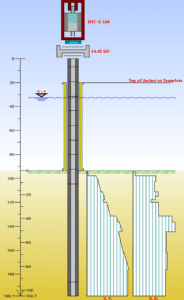Pile Driving Analysis provides added safety to personnel and equipment
Location: Offshore Vietman
Product: Pile Driving Analysis
Background
The operator intended to drill 12 wells (8 production wells and 4 injection wells) for development campaign offshore Vietman. The wells would be drilled and then completed for producing oil & gas. The operator was planning for 4 slots x 36” x 1” OD conductor installation. The conductor penetration depth was targeted at 90m below mudline.
Aquaterra Energy was requested to provide drivability study as part of the engineering scope. The objective of this work was to perform the necessary evaluation and analysis and provide a detailed study to apply casing driving on the 36” casing/ conductor and three desired conductor connectors.
Solution
We performed the driving analysis to predict the maximum penetration depth of the 36” x 1” conductor and to calculate the driving fatigue damages of the conductor and the conductor connectors. In the absence of a drive log in the area, an upper bound and a lower bound soil resistance to driving (SRD) was considered at 50% and 20% of the soil static resistance respectively. Both IHC-S 90 and IHC-S150 hammer were considered in the analysis using GRLWEAP. The driving fatigue damages for the conductor pipe body and the connectors were then calculated considering the axial stress ranges against the conductor depth and blow count.
In total, four different scenarios were considered:
- S90 hammer with the upper bound SRD
- S90 hammer with the lower bound SRD
- S150 hammer with the upper bound SRD
- S150 hammer with the lower bound SRD
The analysis predicted that the 36” x 1” conductor can be driven to a depth between 57.3 m and 89.3 m below mudline, considering an upper bound and a lower bound SRD respectively using a S90, and between 63.1 m and 90 m below mudline, considering an upper bound and a lower bound SRD respectively using a S150 hammer.
The analysis showed that all three desired connectors were not acceptable for either the S90 or the S150 hammer, with a maximum predicted driving fatigue damage above the allowable fatigue damage of 100% for both the S90 hammer and the S150 hammer. Following that, we considered an alternative connector in the driving analysis, which has a good driving fatigue performance based on our experience. The analysis showed that the alternative connector had acceptable driving fatigue damage for both the S90 hammer and the S150 hammer.

Results
As the maximum predicted penetration depth was less than the target depth for both S90 hammer and S150 hammer when considering the upper bound SRD, we recommended to perform an ultimate bearing capacity assessment to determine whether these penetration depths have enough axial capacity to support the well load.
As the analysis showed that the desired conductor connectors had driving fatigue damage beyond allowable, we recommended to use the alternative conductor connector which had acceptable driving fatigue damage for both the S90 hammer and the S150 hammer. However, the client preferred to use one of the desired connectors.As a result of the driving analysis, the client has decided not to drive the 36” x 1” conductor to the target depth and choose to drill instead.
The driving analysis helped the operator to make the decision about their operation early in their planning stage, avoided the potential high fatigue damage to the conductor connectors during the driving operation and the consequences to the operation and personnel safety.
